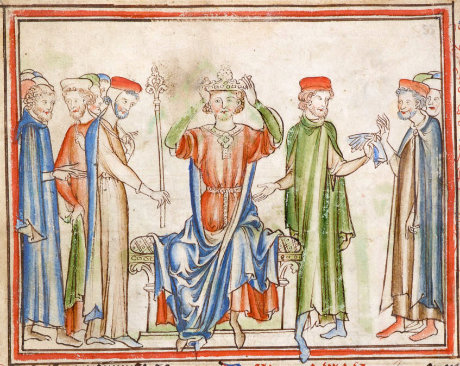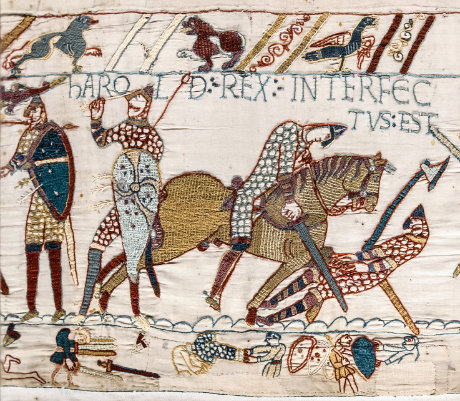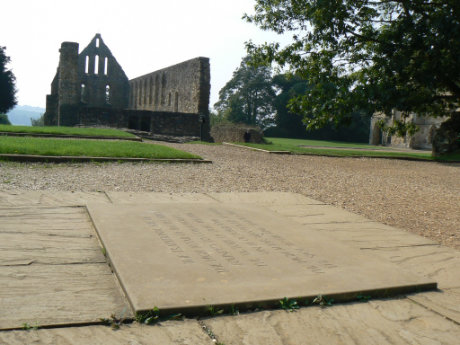Battle of Hastings Fact Sheet
This is a 4-page printable version of the information on our Battle of Hastings page.
&npsp;
The Battle of Hastings is one of the most famous battles in English history, and for many children it is where they start to learn about English history. On this day in 1066, the Normans (led by William of Normandy) fought the Anglo-Saxons (led by Harold II, King of England). It was a bloody battle, but when King Harold was killed, the Normans emerged victorious. William ‘the Conqueror’ took the crown as William I and the English throne changed forever.
When Edward the Confessor died in January 1066, the Witan (a group of royal advisers) declared that the Anglo-Saxon Harold Godwinson was king. He became Harold II.

Harold Godwinson placing the crown on his head to become Harold II
The Witan's decision was disputed by William (Duke of Normandy) and Harold Hardrada (the King of Norway), who both believed the crown was rightfully theirs.
William was a distant cousin of Edward the Confessor. Edward is said to have promised the throne to him (but is also said to have promised the throne to Harold). Hardrada said that former leaders Cnut and Hardicnut had made promises to his father that the throne would be passed to him. What a mess!
In September 1066, Hardrada and his army invaded from the north. King Harold's soldiers marched 250 miles to fight against them at the Battle of Stamford Bridge in Yorkshire. King Harold had to fight against his estranged brother Tostig Godwinson, who have given Hardrada his support. Although King Harold’s men were victorious, an even greater challenge lay ahead of them. While they had been fighting in the north, William had been gathering a great army and an impressive fleet of ships. When the wind and weather conditions were right, this Norman army raced across the English Channel in the cover of darkness. King Harold’s army had to walk the long journey back to confront them. They met at the Battle of Hastings on 14th October 1066.
William’s army was well equipped, some say with up to 15,000 soldiers, archers and knights on horseback. King Harold only had around 5,000 men on foot who were weary from battle. Some of his men were just farmers that he had collected on his march, helping out. The two armies met at Senlac Hill (now known as Battle), about six miles north of Hastings, on the south east coast of England. The Anglo-Saxons started at the top of the hill, with the Normans at the bottom. It was a long, drawn-out battle lasting over nine hours. For a time, the Anglo-Saxons made a wall of shields to protect themselves from flying arrows, and appeared to be holding their ground. Then the Normans made a crafty move, pretending to retreat. When some of the Anglo-Saxons followed them, they left weak points in their defence. The Normans turned around and attacked. Eventually, King Harold was killed along with is brothers Gyrth and Leofwine. Seeing their king killed, many of Harold’s soldiers ran away.

King Harold's death at the Battle of Hastings, depicted by the Bayeux Tapestry
William ‘the Conqueror’ was crowned William I on Christmas Day 1066, and England was now ruled by the House of Normandy.

William the Conqueror

King Harold's memorial stone at Battle Abbey. The stone reads: "The traditional site of the High Altar of Battle Abbey founded to commemorate the victory of Duke William on 14 October 1066. The high altar was placed to mark the spot where King Harold died."
This is a 4-page printable version of the information on our Battle of Hastings page.
Halley's comet is probably the world's most famous - certainly its most well known - comet! It returns to the vicinity of the Earth every 75 years and was last here in 1986. We can next look forward to a visit in about 2061.
William, Duke of Normandy and his Norman troops defeating an exhausted Harold II at the Battle of Hastings, and conquered England, beginning a period of Norman rule. This colouring page depicts a victorious William the Conqueror after the battle.